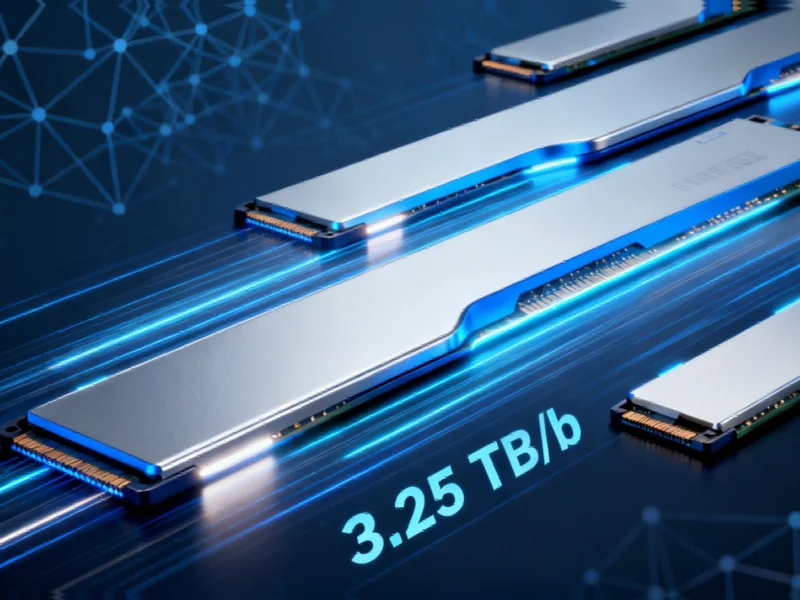Samsung Reveals HBM4E Specifications with Record-Breaking Performance
Samsung has become one of the first manufacturers to detail its HBM4E memory roadmap, with the technology reportedly set to deliver groundbreaking performance improvements for artificial intelligence and high-performance computing applications. According to reports from the Open Compute Project Global Summit, the Korean memory giant showcased specifications indicating the HBM4E will achieve bandwidth speeds of up to 3.25 TB/s, representing nearly 2.5 times the performance of current HBM3E technology.
Technical Specifications and Performance Leap
The report states that Samsung’s HBM4E will operate at speeds of 13 Gbps per stack, enabling the massive 3.25 TB/s bandwidth that could significantly accelerate AI training and inference workloads. This represents a substantial generational improvement over existing High Bandwidth Memory technologies. Analysts suggest this performance leap could enable new capabilities in machine learning systems that require massive data throughput.
Sources indicate the power efficiency improvements are equally impressive, with Samsung claiming nearly double the power efficiency compared to current HBM3E modules. This combination of higher performance and better power characteristics could make the technology particularly attractive for data center applications where both computational throughput and energy consumption are critical considerations.
HBM4 Foundation and Industry Context
The development builds upon Samsung’s HBM4 technology, which reportedly achieves pin speeds of 11 Gbps, significantly exceeding standards set by organizations like JEDEC. Industry observers note that this aggressive timeline comes amid growing demand from AI chip manufacturers, particularly after AMD and NVIDIA reportedly requested accelerated HBM4 solutions to power their next-generation architectures.
The push toward higher data-rate units in memory technology reflects the increasing bandwidth requirements of modern AI workloads. As model sizes continue to grow and training datasets expand, memory bandwidth has become a critical bottleneck in AI system performance.
Market Position and Competitive Landscape
Samsung’s early announcement positions the company favorably in the competitive HBM market, particularly as AI chip manufacturers seek to secure advanced memory supplies for their upcoming products. Local media reports suggest Samsung has become the first manufacturer to achieve these performance milestones, though verification from independent testing laboratories is still pending.
The timing of this announcement coincides with significant industry developments, including TSMC’s expansion of advanced manufacturing capabilities and Microsoft’s continued AI infrastructure investments. These parallel developments highlight the broader industry trend toward specialized hardware optimized for artificial intelligence workloads.
Manufacturing and Implementation Timeline
While Samsung has showcased the technology specifications, mass production timelines remain unspecified. Industry analysts suggest that the transition from demonstration to volume manufacturing typically takes 12-18 months for new memory technologies. The company’s ability to scale production will be crucial for meeting anticipated demand from AI accelerator manufacturers.
The development follows other significant technology announcements across the sector, including Google’s enterprise AI tools and cross-platform streaming initiatives, though Samsung’s focus remains on the underlying hardware infrastructure powering these services.
Industry Implications and Future Outlook
The reported specifications for HBM4E suggest a significant step forward in memory technology that could enable new classes of AI applications and research. As AI models continue to grow in complexity and size, the memory subsystem has become increasingly critical to overall system performance.
Sources indicate that Samsung’s advancements in Korean technology development reflect broader national investments in semiconductor leadership. The company’s progress, as detailed in media coverage and technical presentations, positions it at the forefront of memory technology innovation for the AI era.
Industry observers will be watching for verification of these performance claims and details about production schedules as the technology moves closer to commercialization. The successful implementation of HBM4E could potentially reshape the competitive landscape in AI hardware, though independent testing and real-world performance data will be essential for comprehensive evaluation.
This article aggregates information from publicly available sources. All trademarks and copyrights belong to their respective owners.



